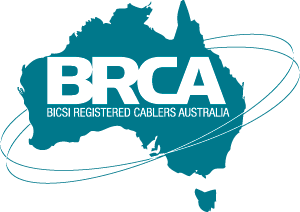END USERS
While a basic cabling registration is all that’s required to work as a cabler it is not what BRCA recommends.
As a small business owner, you need to be aware of the issues that affect your business.
The reality is that you can’t and shouldn’t ignore this issue because, although cabling is somewhat “boring”, and is often hidden in the wall, it plays a critical role in supporting your network and your customers network applications.
These costs include obvious downtime, as well as less apparent slow-time and intermittent faults. Read on to discover how to optimise your network cabling system and ensure the work gets done right – the first time.
WHAT’S THE PROBLEM?
The first problem with infrastructure design is not treating it as a whole. A network can only perform as well or be as reliable as its weakest link, which often turns out to be the physical layer.
Very often cabling systems are:
- Under specified
- Installed by poorly trained contractors
- Wrongly tested or not tested at all,
- Badly maintained; or
- Chosen based upon the lowest quote.
WHAT YOU SHOULD KNOW
- Passive equipment plays an active role in determining network performance.
- Patch cords, often crimped on-site, are the single largest source of cabling faults. They have a significant effect on NEXT and Return Loss – two critical parameters that affect network performance.
- The channel depends on the jack/plug NEXT performance. Thus, poorly terminated patch cord plugs can easily drag channel performance down below what the jacks can compensate for.
Cutting away the cable sheath too much or kinking the cables can upset cable geometry causing echoes that disturb signal throughput.
- Strictly adhering to the standards rule for untwisting wires can improve NEXT by up to 2dB.
- Throughput is exponentially reduced as bit errors (re-transmissions) increase. According to Metcalf’s Law, a 1% retransmission can reduce a 100Mbps link to 20Mbps. A 5% error rate decreases the link to 0.032Mbps and grinds the network to a halt, even while all the green lights are still blinking.
- Some problems only occur after network installation, such as electromagnetic interference (EMI) from building equipment and poor grounding and bonding, which can damage expensive equipment.
- Cable management, labelling and documentation are essential for maintenance, troubleshooting, upgrades and change management.
WHAT CAN YOU DO?
Join BICSI and learn to optimise your network cabling with:
- Technical Education
- Certification & Standards
- Quality Assurance
- Business Integrity
- Business Opportunities
WHAT IS BICSI?
BICSI is an international not-for-profit association with over 20,000 professionals in 110 countries around the world. The organisation’s scope has also broadened beyond wiring buildings to include data networks and applications.
In terms of membership, BICSI has also expanded beyond cabling professionals to include consultants, architects and professionals involved in voice, data, video, audio and low-voltage control transport systems in commercial buildings.
JOIN BICSI
BICSI represents:
- a community of end user IT managers,
- building owners
- integrators (network, system and cabling)
- technology vendors
- architects
- M&E engineers
- network and telecom consultants and;
- other individuals and corporations serving the network infrastructure industry.
BICSI is committed to telecom and network-related vendor neutral training and certification. Organisations recognise BICSI membership as a mark of being at the forefront of current infrastructure standards and practices.
USE THE BICSI RESOURCES
Most cabling problems arise from poor design. To avoid this BICSI provides manuals to help with drawing up project specifications while you can also attend BICSI’s educational seminars and ask your installer/ vendor to keep you updated on these events. There is also the website www.bicsi.com.au where you can source technical information, join discussion forums and obtain quick answers from like-minded professionals.
A BENCHMARK FOR BEST PRACTICES
BICSI’s benchmark certification is the Registered Communications Distribution Designer (RCDD) designation. This qualification is based on international standards such as EIA/TIA, Cenelec, CSA, IEEE, and UL, in addition to region specific standards. RCDDs are globally aware first class infrastructure designers who specify standards-based rather than vendor-based designs.
To qualify to sit the RCDD exam candidates must have at least two years practical experience with telecommunications infrastructure design, complete an experience checklist and provide professional and personal references. If they meet these requirements exam participants must then achieve a 78% mark on more than 20 core subjects. To maintain their certification RCDDs must obtain 45 Continuing Education Credit hours every three years at BICSI-approved technical seminars and courses.
This is why RCDD’s stand out from the rest and why a BICSI RCDD individual (either within your organisation or within the infrastructure design and deployment company that you work with) offers you quality assurance.
So recognise the RCDD logo as a mark of quality and expertise and ensure you request it in your tender documents and job searches.
There are also specialisation extensions, including LAN and OSP (Outside Plant) that RCDDs can pursue to upgrade their skills.
EDUCATION RESOURCES
BICSI maintains some of the most up-to-date resources which provide professional instruction on all aspects of the design and installation of telecom distribution and network systems.
These resources are available as comprehensive information manuals and CD-ROMS, which are used as standard knowledge bases for the RCDD certification and its associated specialisations.
Several BICSI-approved trainers conduct courses based on these resources.
CHOOSE A RELIABLE INSTALLER
Select an infrastructure provider that has in-house RCDD’s and BICSI corporate membership. They reflect a company’s system design expertise and commitment to continuous technical upgrading. Corporate members can use the BICSI logo and you can verify their membership status at www.bicsi.com.au.
WORK WITH REPUTABLE VENDORS
Vendors that live by the BICSI ideals of education, training and high standards know that a well-trained technical workforce is the key in providing value to their customers. That is why all major vendors of cabling/connectivity are corporate BICSI members and have BICSI-trained personnel.
